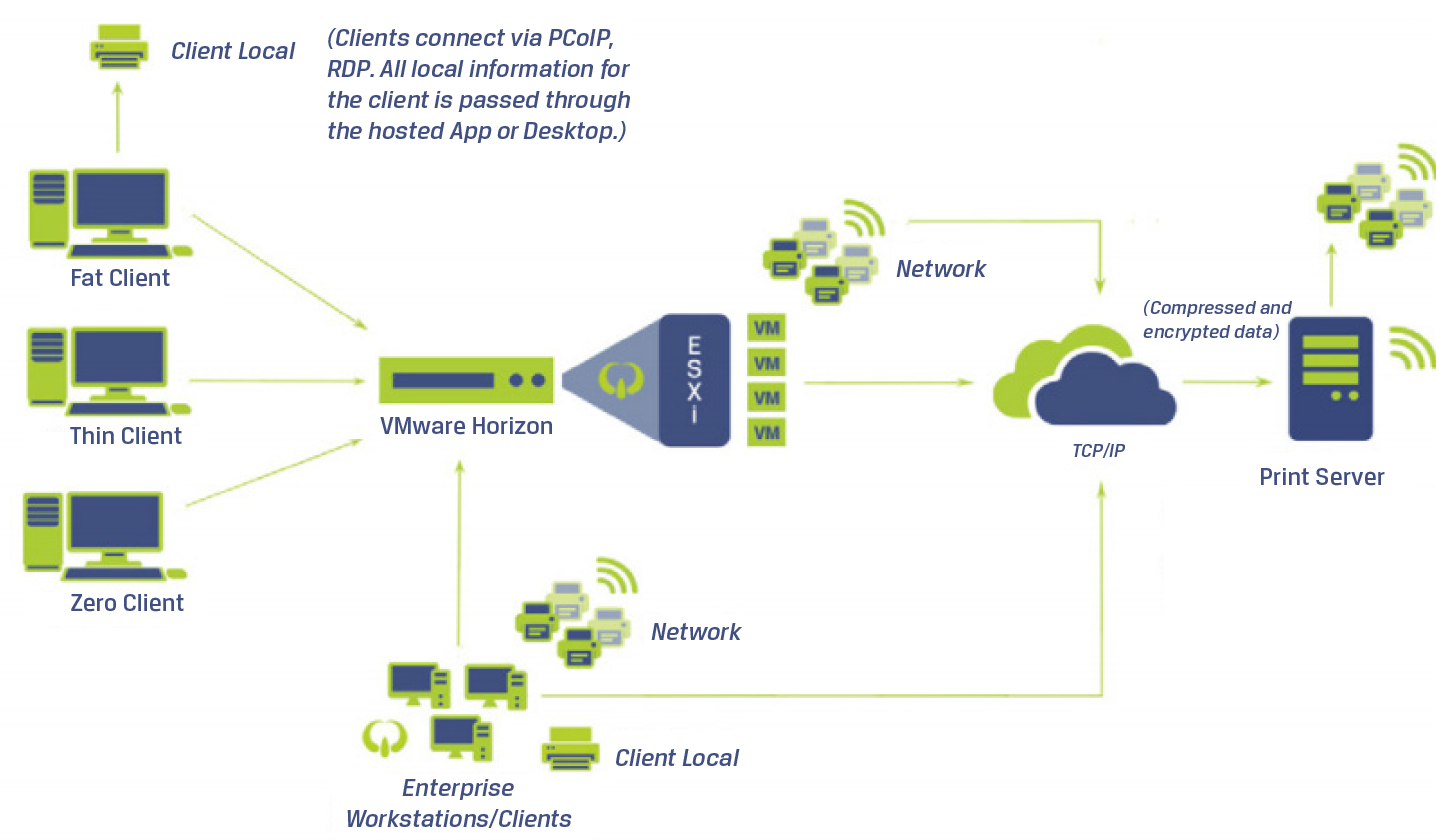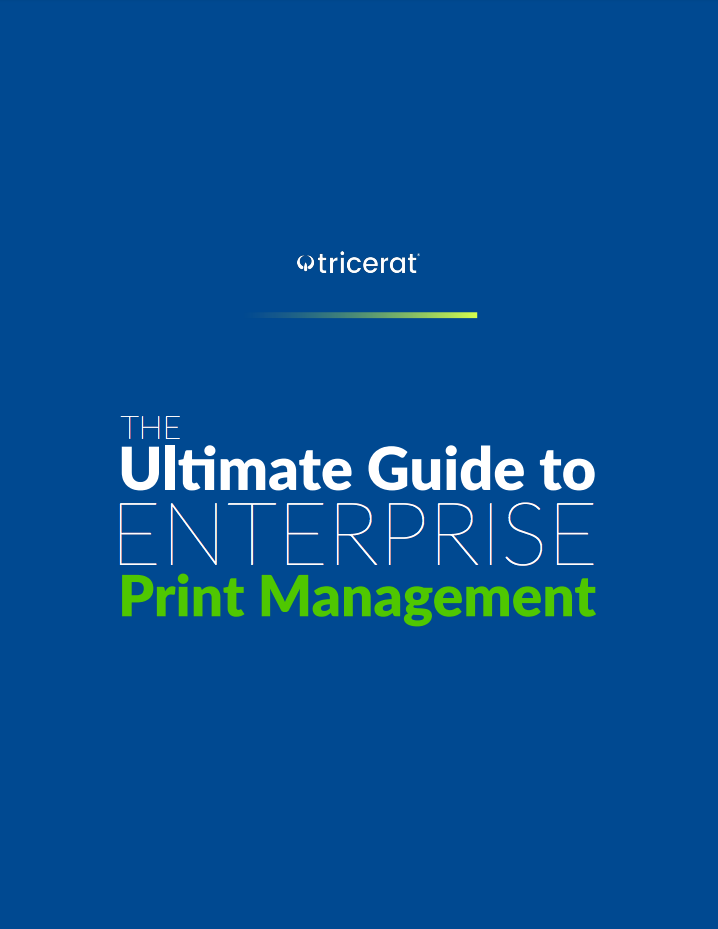Tricerat's Simplify Printing® enhances the capabilities of VMware Horizon environments by enabling reliable printing across remote protocols and providing administrators with management tools to deliver print services to users. By utilizing Simplify Printing, management overhead is reduced and the end user experience is improved.
Simplify Printing works with a variety of environments to deliver common enterprise print management across platforms. Applications or desktops hosted on RDSH, VDI, or physical desktops can have managed print queues. For remote access, RDP, PCoIP, and ICA are supported connection protocols for client printing and any client can have print server queues built in a remote session.
There are two basic print methods that are enabled by Simplify Printing – client printing and print server printing. Administrators may choose one method or a combination of the two to achieve the balance between administrator control and user flexibility.
Simplify Printing includes Tricerat’s ScrewDrivers® technology to enable printers on a Windows client device to be available within a remote session. When a user connects to a VDI or RDSH session, Simplify Printing communicates over virtual channels in PCoIP, RDP or ICA to gather information about printers installed on the client workstation. The ScrewDrivers virtual driver can be the only print driver installed on the VDI image or RDS host, and can present itself as any printer with precise capabilities.
Enterprise print management often revolves around the use of print servers in the environment. If these are present, Simplify Printing can automatically import printers that are on the print servers and enable them to be assigned to users, groups, and workstations in the environment. Through a user interface that is superior to policy management, administrators can easily define who gets which printers, making roll- outs and updates simple and clear.
In many cases, print servers are already present in the environment. Simplify Printing offers an approach that layers on top of the servers that are already in place, enhancing their management and performance. The centralized management of print drivers for enterprise printers has always been an advantage of print servers. Combined with the ScrewDrivers virtual print driver technology, print server management is even easier and benefits are maximized. This is particularly important in a non-persistent disk scenario, where repeatedly copying drivers is an expense of time and performance.
Consider these other benefits of print servers with Simplify Printing:
A common issue with virtual printing products has been the generic capabilities available with print server printers. In many cases, users require access to the more advanced print features available in enterprise print hardware. This might include pin-code printing, stapling, finishing features, or other manufacturer- enabled features.
Tricerat has overcome this limitation by offering Advance Print Features, a method to display the manufacturer print dialog to the user. There is still no need for the manufacturer driver to be installed on the terminal server, yet the user interface can still be accessed and controlled. This brings the advantages of a virtual driver together with the access to manufacturer-specific printer features.
There are many different formats and protocols for document management. PDF (Portable Document Format) accomplishes a generic format viewable on an array of devices. EMF (Enhance Meta Format) is a technology that works very well in traditional Windows client-server printing. However, none of these formats directly meet the challenges associated with virtual drivers and remote desktop printing, where the client and server are isolated from each other except through the virtual channel.
In 2005, Tricerat invented TMF (TriMeta Format) which uses similar techniques as EMF but is engineered specifically for virtual driver technology and remote desktop or VDI scenarios. This enables Simplify Printing to achieve the best possible accuracy in print jobs, even when they are transferred to remote locations and the server does not have the native driver installed.
To enable printing in a VDI scenario, a driver of some type needs to be present for an application to print. A traditional method is to install any necessary printer driver on a VDI image. This takes a lot of administrator management, and might not account for all printers that connect to the VDI instance, particularly if remote or home users are involved.
A second method is to use a driver management solution that automatically installs drivers onto the system. This reduces the amount of management by an administrator, but still requires the driver to be installed at the start of the user session. In the case of a non-persistent VDI, every new instance of a desktop or application will trigger the required drivers to be copied over the network and installed on the virtual desktop. When considering a VDI pool, the amount of processing during user logins could be substantial.
For the ScrewDrivers virtual driver technology in Simplify Printing, a single driver is installed in the base VDI image. This single driver requires a simple query to either the client or the print server to acquire the metadata necessary to present unique printers to the system. There is minimum management overhead, and minimum processing overhead during user logins.
Regardless of the printers in use across the WAN, Simplify Printing can read the capabilities from the printer and handle print jobs from applications. In conjunction with Tricerat’s TMF protocol, optimal compression can be applied directly to the print stream to minimize bandwidth. In the case of remote clients connecting over the WAN, this results in the fastest possible print job delivery.
For print server printing, agents can be deployed to the remote site to manage print traffic between the datacenter and the remote site. The same print compression is applied to print jobs and bandwidth is minimized.
There are several factors to consider which affect scalability:
Simplify Printing utilizes a SQL Server database that contains the configuration information for printer assignments to users and devices. Database size is generally not a concern for configuration data. Database servers need to be configured to handle the SQL queries during a login, the volume of which is dependent on the number of users logging in at the same time. The connection is only active when a user is logging in or refreshing their printers. Other SQL Server features such as clustering or mirroring can enable high availability for the database.
Note: If client printing is the only requirement, ScrewDrivers does not require a database.
There is a 1-to-1 mapping of clients to user sessions. The server component is lightweight with a small service processing session events (logon, logoff, session disconnect and reconnect) to add or remove printers on the system. The driver component is a standard Windows print driver that is invoked when a job is sent to a ScrewDrivers printer.
The one component outside the database server that bears load in larger environments is the print server. The Simplify Printing print server is a service that runs to accept incoming connections for VDI machines or other session hosts. Upon connection, a child process is created to handle the print job from that connection. This occurs each time a user initiates a print job to a print server printer. Each child process uses processor time to process the print job and send it to the Windows Spooler, and consumes a few megabytes of memory, sometimes up to 20 MB.
Because a process is created to handle each print job, increasing the processor cores available on the print server can help increase throughput of print jobs on the print server. The performance of the disk subsystem is also important as jobs move through the Simplify Printing agent and to the Windows Print Spooler before being sent to the printer. In a lab test with average hardware, print servers could process 45 jobs per minute per server.
To further enhance both the scalability and redundancy of print servers, numerous techniques can be utilized. First, printers can be split up among several print servers to distribute the load among print servers. This technique is also useful when printers are spread out among different networks or geographies. Secondly, a load balancer can be utilized to automatically distribute load between multiple print servers. In this case, all print servers behind a load balancer would have identical queues. Load is reduced by a half, a quarter, or more depending on the number of nodes that are load balanced. Additionally, automatic failover can reduce the risk of any print server downtime. Finally, Simplify Printing has the option to specify alternate print servers that can be used when the original print server is unavailable.
With the above considerations in mind, Tricerat recommends the following best practices:
Tricerat’s solutions, such as ScrewDrivers and Simplify Printing, are true enterprise print management software. Time and again, customers come to us to solve issues with ThinPrint in their VMware Horizon deployment. We often see things like the inability to scale past 1,000 client assignments or the need to manage large-scale print queues as roadblocks our customers face. Simplify Printing removes these roadblocks and allows users to utilize a simple administration interface to easily assign printers in VMware Horizon to workstations, no matter the number of assignments needed. Simplify Printing offers the ability to similarly manage physical desktops so that consistent printer assignments are presented to users regardless of the application. The management features gave one administrator the ability to manage the entire environment of over 5,000 workstations. Other customers have seen such benefits such as a reducing in help desk tickets by 30% and cost savings of up to $360,000.
The below diagram shows an example architecture when using Tricerat Simplify Printing in a VMware Horizon environment.

Tricerat Simplify Printing offers enterprise print management capabilities and enables printing scenarios that enhance the end user experience. Simplify Printing extends deployments of VMware Horizon and integrates printing access and control with the full scope of application platform and delivery methods. Administrators have a single Console to manage printer assignments, while users gain consistency and performance. The technology in Simplify Printing is the result of 14 years of development in remote access environments including VMware Horizon.
